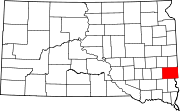Hartford, South Dakota
Hartford is a suburban American city in Minnehaha County, South Dakota, a few miles northwest of Sioux Falls. Its population was 3,354 at the 2020 census.[5]
History
Hartford was named in 1880 after Hartford, Connecticut.[6] An early variant name was Oaksville.[7] A post office has operated here since 1880.[8] The city incorporated in 1896.[9]
Geography
According to the United States Census Bureau, its area is 2.27 square miles (5.88 km2), all land.[10]
Demographics
| Census | Pop. | Note | %± |
|---|---|---|---|
| 1900 | 423 | — | |
| 1910 | 648 | 53.2% | |
| 1920 | 677 | 4.5% | |
| 1930 | 628 | −7.2% | |
| 1940 | 647 | 3.0% | |
| 1950 | 592 | −8.5% | |
| 1960 | 688 | 16.2% | |
| 1970 | 800 | 16.3% | |
| 1980 | 1,207 | 50.9% | |
| 1990 | 1,262 | 4.6% | |
| 2000 | 1,844 | 46.1% | |
| 2010 | 2,534 | 37.4% | |
| 2020 | 3,354 | 32.4% | |
| U.S. Decennial Census[11][4] | |||
2010 census
At the 2010 census there were 2,534 people, 913 households, and 684 families living in the city. The population density was 1,116.3 inhabitants per square mile (431.0/km2). There were 939 housing units at an average density of 413.7 per square mile (159.7/km2). The racial makeup of the city was 96.5% White, 0.6% African American, 1.2% Native American, 0.2% Asian, 0.1% from other races, and 1.4% from two or more races. Hispanic or Latino of any race were 0.6%.[12]
Of the 913 households 45.3% had children under the age of 18 living with them, 62.2% were married couples living together, 9.4% had a female householder with no husband present, 3.3% had a male householder with no wife present, and 25.1% were non-families. 20.0% of households were one person and 7.8% were one person aged 65 or older. The average household size was 2.78 and the average family size was 3.23.
The median age was 31.9 years. 32.7% of residents were under the age of 18; 6.2% were between the ages of 18 and 24; 30.3% were from 25 to 44; 22.7% were from 45 to 64; and 8.3% were 65 or older. The gender makeup of the city was 48.2% male and 51.8% female.
2000 census
At the 2000 census, there were 1,844 people, 661 households, and 534 families living in the city. The population density was 1,236.6 inhabitants per square mile (477.5/km2). There were 675 housing units at an average density of 452.7 per square mile (174.8/km2). The racial makeup of the city was 97.56% White, 0.11% African American, 1.14% Native American, 0.05% Asian, 0.22% from other races, and 0.92% from two or more races. Hispanic or Latino of any race were 0.33% of the population.
Of the 661 households 48.6% had children under the age of 18 living with them, 66.0% were married couples living together, 12.4% had a female householder with no husband present, and 19.1% were non-families. 15.9% of households were one person and 6.1% were one person aged 65 or older. The average household size was 2.77 and the average family size was 3.09.
The age distribution was 32.0% under the age of 18, 6.5% from 18 to 24, 34.7% from 25 to 44, 18.4% from 45 to 64, and 8.5% 65 or older. The median age was 32 years. For every 100 females, there were 95.3 males. For every 100 females age 18 and over, there were 92.3 males.
The median household income was $48,333, and the median family income was $53,942. Males had a median income of $34,792 versus $25,032 for females. The per capita income for the city was $20,726. About 2.8% of families and 3.8% of the population were below the poverty line, including 5.6% of those under age 18 and 7.5% of those age 65 or over.
Notable people
- Ruth Brinker, activist and founder of the nonprofit, Project Open Hand.
- Michael John Fitzmaurice, former United States Army soldier and recipient of the Medal of Honor for his actions in the Vietnam War
- Rhonda Milstead, member of the South Dakota House of Representatives
See also
References
- ^ "SD Towns" (PDF). South Dakota State Historical Society. Retrieved February 13, 2010.
- ^ "ArcGIS REST Services Directory". United States Census Bureau. Retrieved October 15, 2022.
- ^ a b U.S. Geological Survey Geographic Names Information System: Hartford, South Dakota
- ^ a b "Census Population API". United States Census Bureau. Retrieved October 15, 2022.
- ^ "U.S. Census Bureau: Hartford city, South Dakota". www.census.gov. United States Census Bureau. Retrieved February 21, 2022.
- ^ Chicago and North Western Railway Company (1908). A History of the Origin of the Place Names Connected with the Chicago & North Western and Chicago, St. Paul, Minneapolis & Omaha Railways. p. 177.
- ^ Federal Writers' Project (1940). South Dakota place-names, v.1-3. University of South Dakota. p. 40.
- ^ "Minnehaha County". Jim Forte Postal History. Retrieved April 4, 2015.
- ^ "The beginning history". The Hartford Area News. June 1, 2006. p. 22. Retrieved October 15, 2015.
- ^ "US Gazetteer files 2010". United States Census Bureau. Retrieved June 21, 2012.
- ^ United States Census Bureau. "Census of Population and Housing". Retrieved September 23, 2013.
- ^ "U.S. Census website". United States Census Bureau. Retrieved June 21, 2012.
External links
 Media related to Hartford, South Dakota at Wikimedia Commons
Media related to Hartford, South Dakota at Wikimedia Commons











